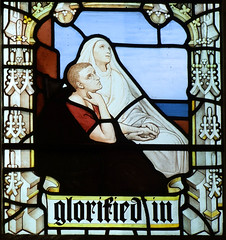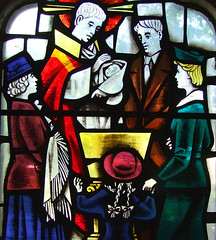| |
|
 |
|
St Augustine, a familiar
landmark to drivers in east Ipswich, was the work
of diocesan architect Henry Munro Cautley.
Cautley was born at Bridge in Kent in 1876, but
when he was eight years old his father Richard
was appointed minister at Ipswich's new All
Saints church in Chavallier Street. Cautley would
spend the rest of his life in Ipswich. He is most
famous today for his epic literary works on
Suffolk and Norfolk churches, but as well as
being diocesan architect he was a partner in an
Ipswich practice with Leslie Barefoot. His best
building on his own is the red brick Ipswich
County Library, and their best together is
probably the Walk, an Elizabethan-style shopping
arcade near to Ipswich's Corn Hill. Cautley was also retained by Lloyds
Bank, and designed a number of improbably
Classical banks for them in the 1920s, mostly in
the east of England. Cautley and Barefoot's
practice was based at Cornhill Chambers in the
Thoroughfare, and the building survives today
with Cautley's lettering above the entrance. The
same lettering can be seen on the war memorials
he designed, of which about half a dozen can be
traced in parish churches in the Ipswich area.
As diocesan architect,
Munro Cautley designed three churches for
Ipswich. St Augustine was the first, in 1927,
bankrolled by Ipswich shop owner Charles Bantoft
in memory of his mother. The site was donated to
the diocese by Lady de Saumerez of Shrubland
Hall. All the work was carried out by firms based
in Ipswich, the main contractor being Charles
Green & Sons of St John's Road. Like many
Ipswich builders, Green was a Methodist, and it
is said that his honesty after discovering he had
underestimated costs led to the firm making just
£20 profit on the two years they spent on the
project.
|
Cautley observed the letter of the
Perpendicular style rather than its spirit, and there is
a central tower, thus not really Suffolk Perpendicular at
all. Perhaps his eyes were wistfully remembering the
great cruciform churches of his childhood in Kent. The
brick walls are rendered, the tower is concrete. Grander
than his St Andrew, Britannia Road, it has none of the
spirit of its age that you find at its 1930s near
neighbour All Hallows, Landseer Road, where Cautley was
on top form both inside and out.
Internally, pretty much all is
Cautley's, the narrow aisles set behind Perpendicular
arcades with panelling reminiscent of Lavenham. There
should be the feel of a grand urban church of the late
15th Century, but the lack of clerestories and the narrow
aisles miss the trick, and the eye is drawn eastwards
rather than upwards.
| The anonymous feel of the
nave enhances the beauty of the chancel, where
steps climb to Cautley's altar and reredos, with
Horace Wilkinson's excellent five-light window
depicting the Ascension of Christ. The interior
would seem rather stark without it. In 1936,
Wilkinson came back and installed the three-light
window in the south transept. It depicts the
Blessed Virgin and Child flanked by St Monica and
St Augustine. Beneath, a charming little vignette
depicts the church's donor Charles Bantoft and
his mother as St Augustine and St Monica. A
plaque beside the window remembers their
donation, but does not name them. The tower contains the bell from the
now-vanished church of Linstead Magna, which was
derelicted the year before St Augustine was
built. Supposedly, the font is from there, too.
But it seems possible that the Linstead Magna
font was actually moved to Linstead Parva church,
and Diocesan architect Cautley pressed the rather
finer Linstead Parva font into service at his
brand new church. The font currently at Linstead
Parva has a face which was once set against an
arcade, but Linstead Parva church has no arcades.
Behind the font is a lively
little window of 1961 by Harry Stammers depicting
an infant being baptised, the family and
godparents gathered around. It is very much in
the familiar Festival of Britain style of the
York school of .stained glass artists. What Henry
Munro Cautley would have thought of it we don't
know, of course, because he died at home in
Ipswich in 1959. His gravestone is in
Westerfield churchyard - he designed it himself.
His wife Mabel, who had died the previous year,
is buried in the same grave.
|
|
 |
|
|
|

